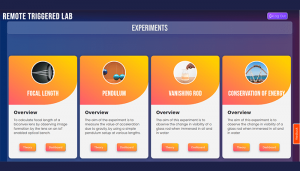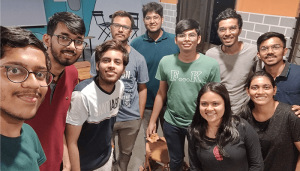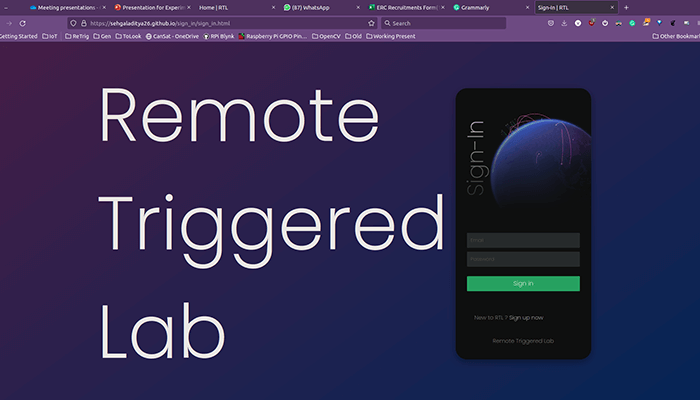Remember the popular high school Chemistry experiment where a glass rod immersed in oil seems to ‘magically’ disappear while the same one in water doesn’t? Now, imagine testing this out and other similar scientific experiments in real while being in another geographical location. IIITH’s Remote Triggered Lab shows just how.
The best way to learn Science is via experimentation. But unfortunately, not all schools and colleges have the required resources or laboratory infrastructure leaving students bereft of a hands-on experience. With pandemic-enforced school closures, this situation was only exacerbated. While the transition to an online mode of instruction saw lab experiments being digitised and conducted in a simulated environment, a virtual experience still lacks physical exposure to the equipment involved. A remote lab in contrast is a blend of both the physical and the virtual – the former by virtue of an actual lab infrastructure existing and the latter due to the manner of conducting the trials from a remote location.


Extending The Virtual Lab
Referring to the collaborative virtual labs initiative that was formally launched in 2012 by the Ministry of Human Resource Development, Dr. Venkatesh Choppella, its Principal Investigator says,” The Virtual Labs project itself at IIITH was doing remote triggered labs a decade ago. Unfortunately, it was much harder to scale at that point and we had to abandon the idea.” He however decided to revisit the idea a year ago when the Kohli Center on Intelligent Systems (KCIS) invited grant proposals for enabling research and development. With KCIS funding the initiative, a faculty team under Dr. Choppella comprising Profs. Sachin Chaudhari, Prabhakar Bhimalapuram, Aftab Hussain, and Harikumar Kandath – each drawing from their expertise in software engineering, IoT, Natural Sciences, Electronics and Robotics respectively – came together to make experimental access to Science more easy and equitable. “We handpicked a bunch of 2nd year undergraduate students who showed promise in their Communications Controls IoT course during the Monsoon semester and asked them to work on this project,” says Prof. Sachin Chaudhari, adding that the student efforts are being led by Viswanadh Kandala, a Dual Degree student who is working on remote triggered labs for his MS thesis.


How Different From Simulation
While the remote lab is an extension of its virtual counterpart, Prof. Chaudhari highlights the difference by demonstrating how actual laboratory equipment can be manipulated via browser controls in an RTL. “In a remote triggered lab, a student, via a dashboard, can control the physical setup of the experiment through sensors and actuators. Though the concept of a remote lab may not be entirely new, what is unique is that our version is low-cost and very efficient requiring minimal compute power thus allowing us to scale it too.” What it means is that one need not necessarily have access to a computer in order to be able to conduct the experiments. All they need is a browser and hence these labs can be controlled even on a mobile device. The entire setup, from the design of the dashboard’s interface to the woodworking skills displayed in the creation of simple physical setups can be credited to the students’ efforts.
What’s In It
Drawing on the strengths of the faculty involved in the project, the project hosts a mix of high school and college experiments from different fields. “We tried to have diversity in the lab studies, from Physics-based experiments such as calculating gravitational constant g using a simple pendulum, to finding the focal length of a convex lens. There’s a titration-related experiment too which is coming from Chemistry. In addition to this we have one on RC circuit which is a classic Electronics and Communications kind of a project,” explains Prof. Chaudhari. The microcontroller – Raspberry 3B+ – is one of the components that is common to all experiments. “It’s widely used, highly durable and supports many other sensors along with activities like live streaming,” says Viswanadh. The dashboard lets students choose the experiment of their choice. Once an experiment is selected, there’s a brief theory for one to read up on before plunging into the practical part of it. “You can change the parameters and then record your observations. For example, the way the convex lens experiment works is that there’s a mirror, a lens and a screen. I can move the light source until I get a sharp image of the light on the screen. From the u and v, I can calculate the focal length,” says Prof. Chaudhari. The dashboard itself has some unique features such as a queuing system that ensures fair usage of the physical equipment. Plus, all user sessions are limited to 5 minutes which are configurable. There is not only live streaming of experiments but also the possibility of recording experimental outputs.
Scaling for Education
With its ability to remove physical constraints of access to labs, the project’s social impact shares common ground with the Raj Reddy Center for Technology and Society whose ultimate aim is to benefit society through AI. “We are building a prototype for an NGO that the Center is working with. The idea is that they will take it and scale it themselves,” says Dr. Choppella admitting that they are yet to address the issue of scaling and have quite a way to go in that yet. Drawing on the experience with Virtual Labs, the team learned that both the production and software interfaces are equally important in getting the labs to work. “There are essentially four layers for each remote experiment – the front-end, the middleware, IoT, and the physical equipment itself. The lessons that we carried over from our experience with Virtual Labs is that we have to get these interfaces right,” he says.
At the recently held R&D Showcase, the Remote Triggered Labs initiative walked away with the Best Poster Award as well as the Best Showcase Demo award garnering a total of 15 stars, each one awarded by faculty. “We want to make it available nation-wide soon. For now, it will continue as a research project where we will refine its robustness, improve its pedagogy and find ways to scale the solution,” says Prof. Chaudhari.
To see how it works, click here.
Sarita Chebbi is a compulsive early riser. Devourer of all news. Kettlebell enthusiast. Nit-picker of the written word especially when it’s not her own.

